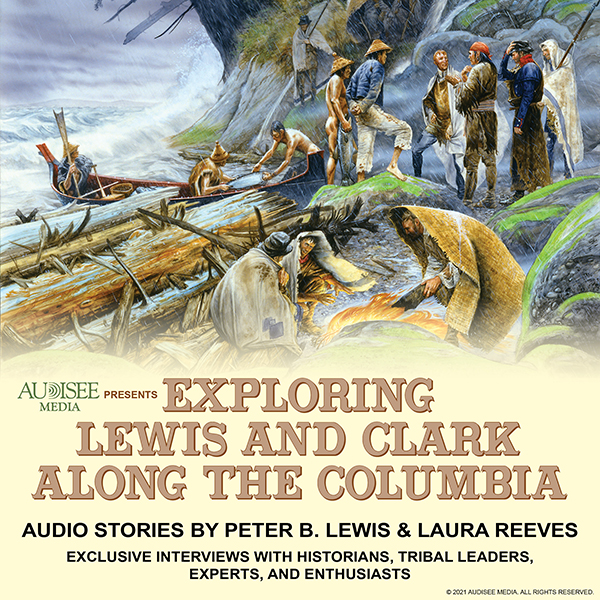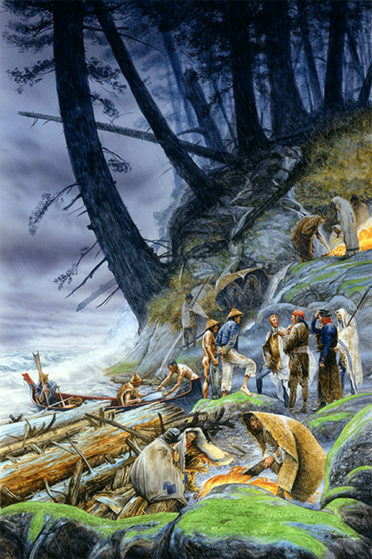Exploring Lewis and Clark Along the Columbia

Peter provides a fascinating audio guide to exploring the long-ago trail of Lewis and Clark along the Columbia river. 3.2 hours.
Welcome to the Lewis and Clark Trail, as you have never experienced it! Guided by the voices of historians, native elders and other experts, you’ll relive this historic odyssey: hear authentic music of the expedition, dozens of authentic natural sounds and the words of Meriwether Lewis, William Clark and others, as you rediscover the adventure, wildlife and culture along this remarkable “Trail of Discovery.” This audio story includes exclusive interviews with Dr. Gary Moulton, editor of the “Journals of the Lewis and Clark Expedition.” As well as modern day tribal leaders and descendants of those who met and aided the Corps of Volunteers for Northwestern Discovery more than 200 years ago.
Purchase Exploring Lewis and Clark Along the Columbia
Also available for purchse at
“This audiobook is a treasure and a delight . . . I believe young and old alike will thoroughly enjoy this engrossing Picture of one aspect of this country's history."
— Donald Goldmacher, Producer
“ I had this playing on my work computer all afternoon and really enjoyed it. I had heard portions of it before, but it had been awhile. It is really well done."
— Sally Freeman, Park Ranger, Lewis and Clark National Historical Park, Fort Clatsop

NOTES ON THE PAINTING
Captain William Clark's journal entry of November 11, 1805 described the day as being “truly a disagreeable one," but that scarcely covered the situation. After days of rain and wind the Corps of Discovery was trapped on a wave-beaten stretch of shore just miles from their ultimate goal, the Pacific Ocean. Soaked to the skin by the continuous downpour, their leather clothing literally rotting off their backs, the members of the expedition huddled around fires for warmth in a vain attempt to dry their few remaining garments and blankets. Unable to paddle forward or back because of the tremendous surf, the Corps had been forced into a shallow bay ringed by steep, rain-sodden hillsides that offered no protection. Stones, dislodged by the torrents of rainwater from the hillsides above, fell on the crew. At high tide, those that hadn't found shelter in the rocks and crevices were forced to sit and sleep on the massive logs that floated in clusters along the shoreline. Many became sick from the brackish water and the constant undulation of the logs, and there was the very real danger of being crushed if one wasn't careful. Because of the lack of space available on shore the baggage had been placed on a rock at a separate location, leaving the crew with no clothing or supplies other than what they had with them. The food supply had been reduced to pounded fish.
As members of the expedition fought to improve their situation and impatiently waited for the weather to moderate they were astonished to see a small canoe with five Indians paddle into the cove through “...tremendious waves brakeing with great violence against the Shores." These Indians were most likely Chinook, and their canoe was loaded with salmon. The Chinook traded 13 salmon for some fish hooks and other “trifling things," giving the men the first fresh food they'd tasted in days.
The cove that sheltered the expedition is almost directly across the river from present day Astoria, Oregon and the steep hillsides that hemmed them in are now cut by Highway 401, which follows the river.
The painting depicts trading which took place between the five Chinook and George Drouillard using sign language. A bareheaded Clark and Lewis, in his officer's surtout, attempt to get the most from the transaction. The men of the expedition are scattered among the moss-covered rocks, wrapped in whatever protection is available to them. Some of the men had picked up mats, woven of cedar bark and cattails, from Indian villages upstream and were sheltering beneath them. By this stage in the expedition cloth
clothing was scarce and the leather items were rotting faster than they could make them, leaving many of the men almost naked. As demonstrated by a bruising hail storm some months earlier, most of the men were probably without hats.
As the rain pounded the men, the Chinook seemed indifferent to the conditions. Inured to the wet and cold, their only concession to the weather was their conical hats, tightly woven to repel water, and occasionally a bear or elk hide robe. One of the men shows the traditional flattened head, a symbol of high status within the tribe. The cedar canoes that were crafted by the coastal tribes were of one log that was beautifully chipped, carved, and painted.
In the canoe is a basket of wapato, a starchy tuber that was a staple of the Chinook diet. The man in the foreground is mentioned in Clark's journal as being dressed in an old sailor's jacket and trousers. Although in general the journals of the two Captains are dismissive of the Coastal Indians, Clark revealed his admiration for their skill as watermen in his entries for November 11. On this rain-swept coast, through the pounding surf, Clark wrote, “the Indians left us and Crossed the river which is about 5 miles wide through the highest Sees I ever Saw a Small vessel ride, Their Canoe is Small, many times they were out of Sight before the were 2 miles off. Certain it is they are the best canoe navigators I ever Saw."
* All quotes from William Clark's journal entries dated November 11, 1805
You must be logged in to post a comment.